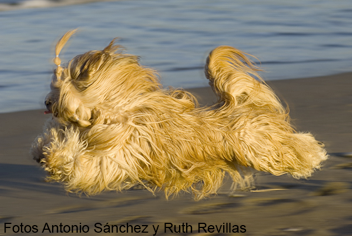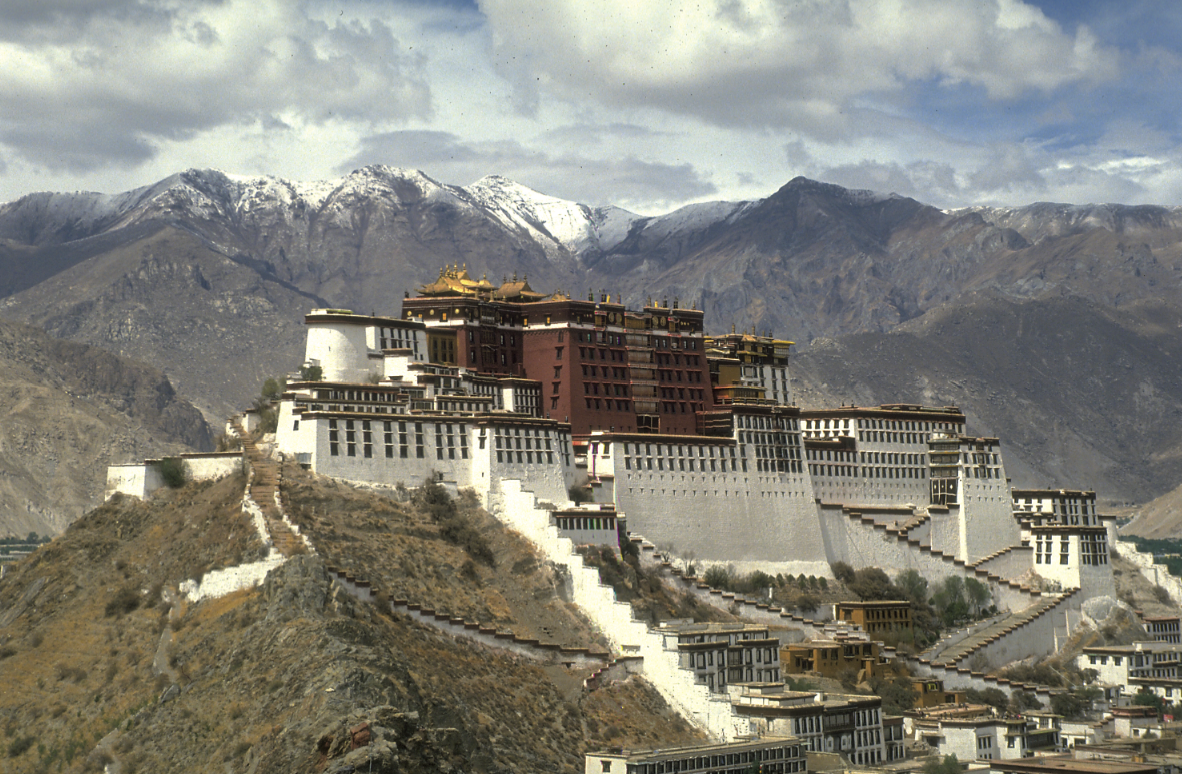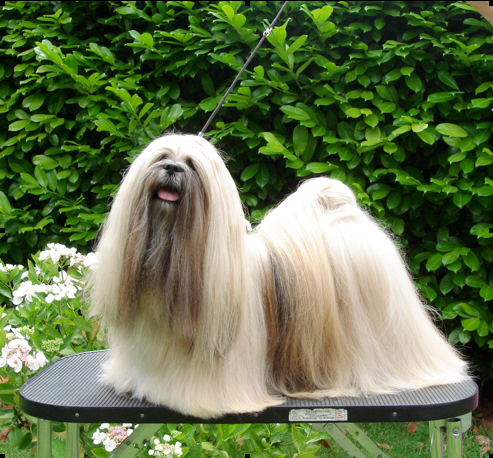Officiële rasstandaard Federation Cynologique Internationale
onderaan deze pagina
staat de Nederlandse vertaling
RASSTANDAARD,
FCI-Standard N° 227 / 24. 06. 2015 / GB
LHASA APSO
ORIGIN: Tibet
PATRONAGE: Great Britain.-
DATE OF PUBLICATION OF THE OFFICIAL VALID STANDARD:
-
FCI-St. N°
227 / 24.06.2015
UTILIZATION: Toy Dog.
FCI-CLASSIFICATION: Group 9 Companion and Toy Dogs.
Section 5 Tibetan breeds.
Without working trial.
-
BRIEF HISTORICAL SUMMARY: The Lhasa Apso comes from Tibet where many
live at high altitudes and the climate can be severe. He has to be a
hardy little dog to withstand these conditions, and this has had a great
influence on his development. His long, hard coat with its dense
undercoat acts as insulation during winter, and the fall of hair over
his eyes protects them from the wind, dust and glare.
The Lhasa Apso is one of several Eastern breeds to come to the West. The
first Lhasa Apsos arrived in Britain in the early 1920s and were being
shown in London soon after. When they were first seen in Britain they
were confused with other shaggy Oriental dogs and all were labelled
‘Lhasa Terriers’. Later a distinction was made, especially between the
Apso and the Tibetan Terrier which is thought to have been behind the
early Apsos. A breed club for the Lhasa Apso was established in Britain
in 1933.
-
GENERAL APPEARANCE: Well balanced, sturdy, heavily
coated, without excess.
-
IMPORTANT PROPORTIONS: Length from point of shoulders to point of
buttocks greater than height at withers.
-
BEHAVIOUR AND TEMPERAMENT: Gay and assertive. Alert, steady but somewhat
aloof with strangers.
-
HEAD: Head furnishings with fall over eyes; but not affecting the dog’s
ability to see, good whiskers and beard.
-
CRANIAL REGION:
Skull: Moderately narrow, falling away behind eyes, not quite flat, but
not domed or apple headed.
Stop: Medium.
-
FACIAL REGION:
Nose: Black.
Muzzle: About 4cms, but not square; length from tip of nose roughly one
third of total length from nose to back of skull. Foreface straight.
Jaws / Teeth: Upper incisors close just inside lower i.e. reverse
scissor bite. Incisors in a broad and as straight a line as possible.
Full dentition desirable.
Eyes: Dark. Medium size, frontally placed, oval, neither large nor full,
nor small and sunk. No white showing at base or top.
Ears: Pendant, heavily feathered.
-
NECK: Strong and well arched.
-
BODY: Balanced and compact.
Topline: Level.
Loin: Strong.
Chest: Ribs extending well back.
TAIL: High set, carried well over back but not like a pot-hook.
Often a kink at end. Well feathered.
-
LIMBS
-
FOREQUARTERS:
Shoulder: Well laid back.
Forearm: Forelegs straight, heavily furnished with hair.
Forefeet: Round, cat-like with firm pads. Well feathered.
-
HINDQUARTERS:
General appearance: Well developed with good muscle. Good angulations.
Heavily furnished with hair.
Metatarsus (Rear pasterns): Hocks when viewed from behind
parallel and not too close together.
Hind feet: Round, cat-like with firm pads. Well feathered.
-
GAIT / MOVEMENT: Free and jaunty.
-
COAT:
Hair: Top coat long, heavy, straight, hard neither woolly nor silky.
Moderate undercoat. Coat never impeding action.
Colour: Golden, sandy, honey, dark grizzle, slate, smoke, particolour,
black, white or brownish. All equally acceptable.
-
SIZE:
Ideal height at the withers: Males: 25 cms, females slightly smaller.
-
FAULTS: Any departure from the foregoing points should be considered a
fault and the seriousness with which the fault should be regarded should
be in exact proportion to its degree and its effect upon the health and
welfare of the dog.
-
DISQUALIFYING FAULTS
· Aggressive or overly shy.
· Any dog clearly showing physical or behavioural abnormalities shall be
disqualified.
N.B.:
· Male animals should have two apparently normal testicles fully
descended into the scrotum.
· Only functionally and clinically healthy dogs, with breed typical
conformation should be used for breeding.
-
-
Officiële rasstandaard Nederlandse vertaling
ALGEMEEN UITERLIJK: Harmonieus, stoer, zwaar behaard, zonder
overdrijving.
-
BELANGRIJK PUNT:
lengte van punt van het boeggewricht tot zitbeenknobbels is groter dan
hoogte bij de schouder punten.
-
GEDRAG/TEMPERAMENT: Vrolijk en zelfverzekerd. Alert, rustig, maar
enigszins afstandelijk naar vreemden.
·
HOOFD: Veel
beharing op het hoofd dat over de ogen valt, maar het zicht niet mag
hinderen, flinke snor en baard haren.
-
SCHEDEL:
matig smalle schedel, terugvallend achter de ogen,
niet vlak, maar ook niet gewelfd of een appelhoofd.
Rechte voorsnuit
met matige stop, neus zwart, neusrug ongeveer 4 cm lang, niet vierkant.
Lengte van neuspunt tot stop is ruwweg 1/3 van de totale hoofdlengte
(achterhoofdsknobbel).
OGEN: Donker. Middelmatig groot, frontaal geplaatst, ovaal. Niet groot en bol,
ook niet klein en diepliggend. Geen wit zichtbaar onder en boven iris.
OREN: Hangend, zwaar bevederd.
-
GEBIT: Bovenste snijtanden vallen net binnen de onderste
snijtanden m.a.w. een omgekeerd schaargebit. Snijtanden staan in een
brede, zo recht mogelijke lijn. Volledig gebit is wenselijk.
-
NEK: Sterk en
goed gebogen.
-
VOORHAND:
schouders goed terugliggend, rechte voorbenen, zwaar behaard.
-
LICHAAM:
lengte van punt van het boeggewricht
tot zitbeen knobbels is groter dan hoogte bij de schouder punten. Ribben
goed naar achter doorlopend, rechte ruglijn, sterke lendenen.
-
ACHTERHAND:
Goed ontwikkeld met goede spieren, goede gehoekt. Zwaar
behaard.
de hakken wanneer bekeken vanachter; parallel en niet te dicht bij
elkaar.
-
VOETEN: Rond, katachtig met stevige kussentjes. Goed bevederd.
-
GANGWERK / BEWEGING: Vrij en kwiek
-
STAART: Hoog aangezet, goed over de rug gedragen, maar niet als een
handvat. Vaak een knik aan het einde. Goed bevederd.
-
VACHT:
bovenvacht lang, zwaar,recht, hard, niet wollig of zijdeachtig. Matige ondervacht.
Vacht mag de beweging niet hinderen.
KLEUR: Goud, zand, honing, donker grijs, leigrijs, rook, meerkleurig,
zwart, wit of bruin. Alle kleuren gelijkwaardig geaccepteerd.
-
GROOTTE: Ideale hoogte: 25,4 cm schofthoogte voor reuen; teefjes iets
kleiner.
·
FOUTEN: Iedere afwijking van de voorgaande punten dient beschouwd te
worden
als een fout. De zwaarte waarmee de fout beoordeeld dient te worden
dient in exacte proportie te staan tot de mate van invloed en het effect
dat de fout heeft op de gezondheid en het welbevinden van de hond.
Iedere hond die duidelijk lichamelijke of gedragsmatige afwijkingen
vertoont dient te worden gediskwalificeerd.
Reuen dienen twee normaal ontwikkelde, volledig in het scrotum
ingedaalde testikels te hebben.
voor eventuele vertaal fouten zijn wij niet verantwoordelijk.
|
Rasstandaard
Rastandaard pdf


 |